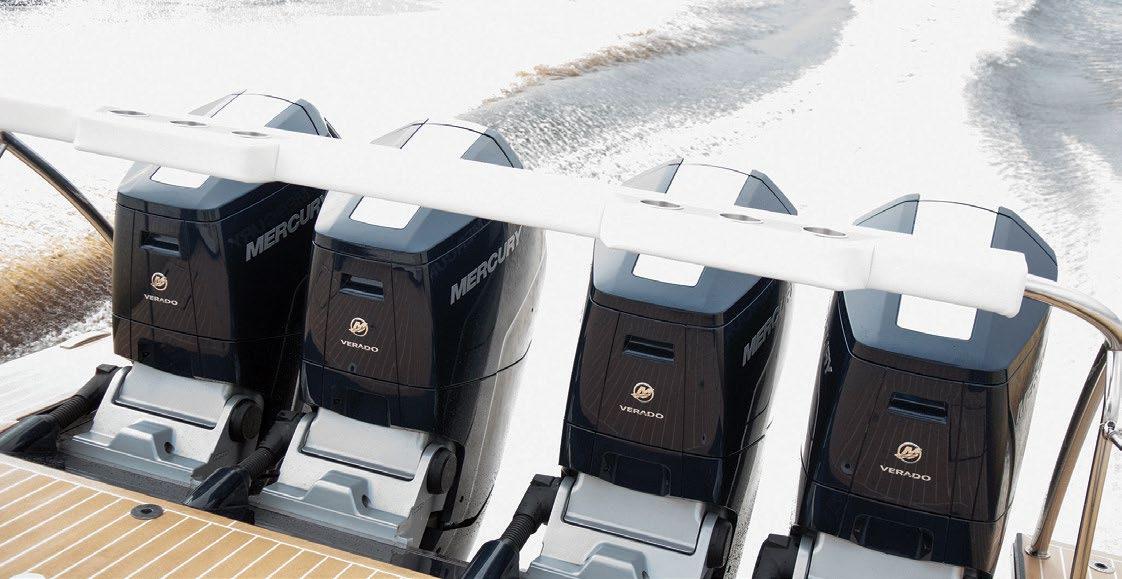
4 minute read
Electronics
GLENN HAYES is a marine writer and photographer whose background in the marine industry and in marine electronics spans almost three decades and many thousands of miles at sea traveling the world. He can be reached at
The Modern Outboard
Today’s outboards are more innovative than ever.
If you’re in the market for a new outboard or an outboard-powered boat, you’ll be looking at the most innovative motors to ever hit the market. With the popularity of outboards surpassing inboards and outdrives in many markets, and ever larger boat designs requiring more ponies, engine manufacturers have had to come up with technologically advanced solutions to capture market share and performance requirements. The results are impressive.
At the top-end of the outboard hierarchy is the multi-engine boat that requires dual, triple, quad or even quint outboards to propel and perform to everincreasing expectations. A visit to any boat show will reveal a bevy of craft bristling with high horsepower outboards. But as the size and length of these new craft grow larger, even quint outboards may not suffice.
Meet the new Merc Enter the Mercury Marine 600-hp V-12 7.6-liter Verado outboard. Chock-full of new features, this naturally aspirated outboard answers a lot of needs and leads the way to the future in outboards. Over five years in the making, this motor was designed by Mercury’s engineers from the ground up for one purpose: To power large, heavy yachts that demand tremendous horsepower and performance. Each of these 600-hp outboards can take the place of two smaller engines and do so admirably. One can only assume that unique features, such as the first seamless two-speed transmission in an outboard, will work their way into other outboards.
Starting with the Mercury-designed and manufactured narrow V-12 engine block, these engines are designed to stand vertically, taking up less room on the transom despite the massive horsepower rating. Mountable 27 inches on center, these monsters are virtually touching each other. They are able to do this because they don’t pivot the way traditional outboards do. They remain fixed in position, and just the drive unit below the waterline turns. This allows for more room on the transom for either more engines or valuable swim platform space. Electro hydraulically actuated, these lower units utilize dual prop configurations, giving the large vessels they are pushing incredible mobility and thrust. While under joystick control, these lower units can swing up to 30 degrees port and starboard, and outer motors can swing as far as 45 degrees. Engineering marvels Another innovation these outboards sport is a high-output charging system. Today’s boats are laden with power hungry electronics of all kinds. Outputting a regulated 150 amps, these engines can charge onboard batteries quickly and keep them topped up. They can even sense when a battery is low and increase idle speed to help charge faster. High power output is not restricted to just the Mercury Verado; Yamaha recently announced that some of its outboards now have similar capability, increasing output 40% to 70 amps. Yamaha has also taken advantage of this higher output capability and developed an all-new battery management system that requires just two starting batteries no matter how many outboards you have. This system also allows remote battery switching with a wireless fob. This can be a particularly useful feature for early morning starts in the dark; just leave some light switches on and turn on lights and batteries all at once.
Yet another engineering marvel found on the V-12 that’s becoming more common with other manufacturers is automatically redirecting the exhaust from exiting the center of the duo-prop while in reverse and moving it above the cavitation plate. This allows less chance of the props becoming aerated and losing traction while in reverse. It’s particularly useful when trying to back down and maneuver one of these larger outboard yachts. Speaking of duo-props, it used to be that you only used that technology on outdrives, but their effectiveness in providing thrust with larger heavier boats means that they now can be found on outboards such as the V-12 and Suzuki’s largest outboards.
Something that Mercury is particularly proud of with its new 600-hp V-12s is how quiet they are. These massive outboards are so stealth that they actually removed the telltale stream of water indicating adequate cooling found on other outboards, because when the engines were running at idle that is pretty much all you could hear. Even running at top speed, you can barely hear these engines over the wind and water under the hull.
Thanks to a booming outboard market, larger boats and the subsequent battle to capture market share, it’s clear that today’s outboards are more powerful, efficient, intuitive and intelligent than ever before. ★











